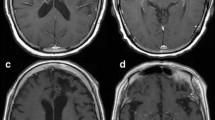Abstract
The incidence of primary central nervous system lymphoma (PCNSL) has increased over the past two decades. The MR imaging appearance of PCNSL plays a central role in the initial diagnosis, management and follow-up of patients. The purpose of this study was to describe the presence and frequency of the pre-contrast T1 hyperintensity (T1h) that is sometimes identified in the region of enhancing neoplastic disease following treatment of PCNSL. We also explored possible causes for this phenomenon that, to the best of our knowledge, has not been previously described. The MR imaging and relevant medical records of 221 patients with pathologically confirmed PCNSL were retrospectively reviewed. Only patients with both treatment and follow-up imaging at our institution were eligible for inclusion in the study. Patients with evidence of post-procedural blood products (pre-contrast bright T1 lesions) prior to the initiation of therapy were excluded. Out of 221 patients, 119 met the eligibility criteria and were included in this investigation. Following treatment, 75 patients (63 %) developed pre-contrast T1h not attributable to blood products. All patients with this finding had been treated with methotrexate chemotherapy. The development of pre-contrast T1h following treatment for PCNSL is common. The hyperintense T1 signal in these patients may be caused by the biochemical response of tumor cells to treatment. To assess the prognostic significance of this novel finding, additional studies focusing on disease recurrence and patient survival are warranted.



Similar content being viewed by others
Abbreviations
- GRE:
-
Gradient recalled echo
- FLAIR:
-
Fluid-attenuated inversion recovery
- PCNSL:
-
Primary central nervous system lymphoma
- SWI:
-
Susceptibility-weighted imaging
- T1h:
-
T1 hyperintensity
References
Olson JE, Janney CA, Rao RD et al (2002) The continuing increase in the incidence of primary central nervous system non-Hodgkin lymphoma: a surveillance, epidemiology, and end results analysis. Cancer 95:1504–1510
Sierra del Rio M, Rousseau A, Soussain C, Ricard D, Hoang-Xuan K (2009) Primary CNS lymphoma in immunocompetent patients. Oncologist 14:526–539
Eby NL, Grufferman S, Flannelly CM, Schold SC Jr, Vogel FS, Burger PC (1988) Increasing incidence of primary brain lymphoma in the US. Cancer 62:2461–2465
Jack CR Jr, Reese DF, Scheithauer BW (1986) Radiographic findings in 32 cases of primary CNS lymphoma. AJR Am J Roentgenol 146:271–276
Kuker W, Nagele T, Thiel E, Weller M, Herlinger U (2005) Primary central nervous system lymphomas (PCNSL): MRI response criteria revised. Neurology 65:1129–1131
Haldorsen IS, Espeland A, Larsson EM (2011) Central nervous system lymphoma: characteristic findings on traditional and advanced imaging. AJNR Am J Neuroradiol 32:984–992
DeAngelis LM (1990) Primary central nervous system lymphoma imitates multiple sclerosis. J Neurooncol 1990(9):177–181
Ayuso-Peralta L, Orti-Pareja M, Zurdo-Hernandez M et al (2001) Cerebral lymphoma presenting as a leukoencephalopathy. J Neurol Neurosurg Psychiatry 71:243–246
DeAngelis LM (1993) Cerebral lymphoma presenting as a nonenhancing lesion on computed tomographic/magnetic resonance scan. Ann Neurol 33:308–311
Johnson BA, Fram EK, Johnson PC, Jacobowitz R (1997) The variable MR appearance of primary lymphoma of the central nervous system: comparison with histopathologic features. AJNR Am J Neuroradiol 18:563–572
Lai R, Rosenblum MK, DeAngelis LM (2002) Primary CNS lymphoma: a whole-brain disease? Neurology 59:1557–1562
Glass J, Gruber ML, Cher L, Hochberg FH (1994) Preirradiation methotrexate chemotherapy of primary central nervous system lymphoma: long-term outcome. J Neurosurg 81:188–195
Abrey LE, DeAngelis LM, Yahalom J (1998) Long-term survival in primary CNS lymphoma. J Clin Oncol 16:859–863
Ferreri AJ, Reni M, Villa E (2000) Therapeutic management of primary central nervous system lymphoma: lessons from prospective trials. Ann Oncol 11:927–937
Fliessbach K, Urbach H, Helmstaedter C et al (2003) Cognitive performance and magnetic resonance imaging findings after high-dose systemic and intraventricular chemotherapy for primary central nervous system lymphoma. Arch Neurol 60:563–568
Neuwelt EA, Guastadisegni PE, Varallyay P, Doolittle ND (2005) Imaging changes and cognitive outcome in primary CNS lymphoma after enhanced chemotherapy delivery. AJNR Am J Neuroradiol 26:258–265
Cakirer S, Karaarsian E, Arslan A (2003) Spontaneously T1-hyperintense lesions of the brain on MRI: a pictorial review. Curr Probl Diagn Radiol 32:194–217
Bonneville F, Cattin F, Marsot-Dupuch K, Dormant D, Bonneville JF, Chiras J (2006) T1 signal hyperintensity in the sellar region: spectrum of findings. Radiographics 26:93–113
Rubenstein J, Fischbein N, Aldape K, Burton E, Shuman M (2002) Hemorrhage and VEGF expression in a case of primary CNS lymphoma. J Neurooncol 58:53–56
Kim IY, Jung S, Jung TY, Kang SS, Choi C (2008) Primary central nervous system lymphoma presenting as an acute massive intracerebral hemorrhage: case report with immunohistochemical study. Surg Neurol 70:308–311
Kimura N, Ishibashi M, Masuda T et al (2009) Primary central nervous system lymphoma with cortical laminar hemorrhage. J Neurol Sci 15(287):281–284
Rogers LR (2003) Cerebrovascular complications in cancer patients. Neurol Clin 21:167–192
Wall RT, Harlan JM, Harker LA, Striker GE (1980) Homocysteine-induced endothelial cell injury in vitro: a model for the study of vascular injury. Thromb Res 18:113–121
Ling Q, Hajjar KA (2000) Inhibition of endothelial cell thromboresistance by homocysteine. J Nutr 130(suppl.):373–376
Haimes AB, Zimmerman RD, Morgello S et al (1989) MR imaging of brain abscesses. AJR Am J Roentgenol 152:1073–1085
Baba A, Yamagami S, Mizuo H, Iwata H (1980) Microassay of cysteine sulfinic acid by an enzymatic cycling method. Anal Biochem 101:288–293
Pullan LM, Olney JW, Price MT et al (1987) Excitatory amino acid receptor potency and subclass specificity of sulfur-containing amino acids. J Neurochem 49:1301–1307
Curras MC, Dingledine R (1992) Selectivity of amino acid transmitters acting at N-methyl-D-aspartate and amino-3-hydroxy-5-methyl-4-isoxazolepropionate receptors. Mol Pharmacol 41:520–526
Conflict of interest
None
Author information
Authors and Affiliations
Corresponding author
Rights and permissions
About this article
Cite this article
Karimi, S., Hatzoglou, V., Punia, V. et al. Post-treatment T1 shortening in primary CNS lymphoma. J Neurooncol 111, 25–31 (2013). https://doi.org/10.1007/s11060-012-0984-3
Received:
Accepted:
Published:
Issue Date:
DOI: https://doi.org/10.1007/s11060-012-0984-3




